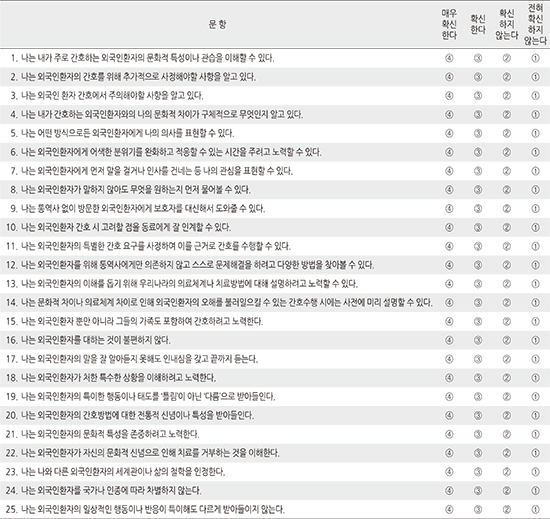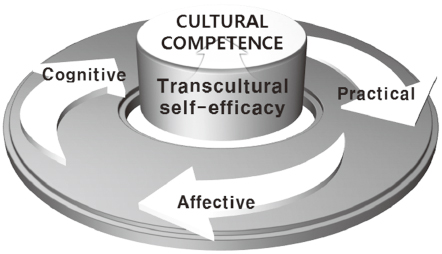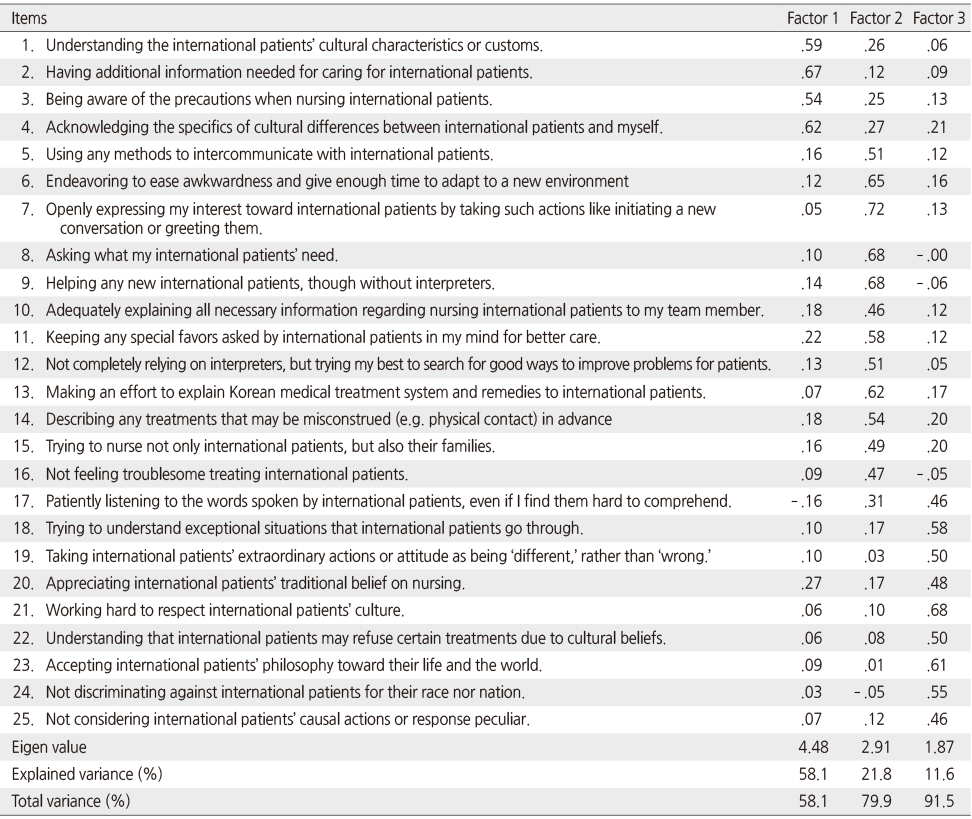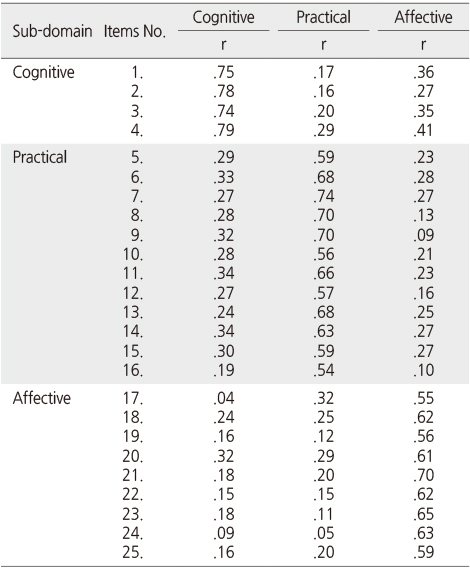Articles
- Page Path
- HOME > J Korean Acad Nurs > Volume 46(2); 2016 > Article
-
Original Article
- Development and Psychometric Evaluation of the Transcultural Self-efficacy Scale for Nurses
- Won-Oak Oh, Eun Sook Park, Min Hyun Suk, Yeo Jin Im
-
Journal of Korean Academy of Nursing 2016;46(2):293-304.
DOI: https://doi.org/10.4040/jkan.2016.46.2.293
Published online: April 29, 2016
1College of Nursing, Korea University, Seoul, Korea.
2College of Nursing, Cha University, Pochon, Korea.
3College of Nursing Science, Kyung Hee University, Seoul, Korea.
- Address reprint requests to: Suk, Min Hyun. College of Nursing, Cha University, 120 Hearyong-ro, Pocheon 11160, Korea. Tel: +82-31-8017-5851, Fax: +82-31-725-8329, chnursing@cha.ac.kr
© 2016 Korean Society of Nursing Science
This is an Open Access article distributed under the terms of the Creative Commons Attribution NoDerivs License. (http://creativecommons.org/licenses/by-nd/4.0/) If the original work is properly cited and retained without any modification or reproduction, it can be used and re-distributed in any format and medium.
Abstract
-
Purpose
- This methodological study was conducted to develop and psychometrically test the Transcultural Self-efficacy scale (TCSEscale) for nurses.
-
Methods
- Initial 41 items for the TCSE-scale were generated based on extensive literature reviews and in-depth interviews with 18 nurses who had experience in caring for foreign patients. Cultural Competence and Confidence model was used as a conceptual framework. Content validity was evaluated by an expert panel. Psychometric testing was performed with a convenience sample of 242 nurses recruited from four general hospitals in the Seoul metropolitan area and Gyeonggi-do province of South Korea. To evaluate the reliability of TCSE-scale, a test-retest reliability and an internal consistency reliability were analyzed. Construct validity, concurrent validity, criterion validity, convergent validity and discriminative validity were used to evaluate the validity.
-
Results
- The 25-item TCSE-scale was found to have three subscales-Cognitive, Practical, and Affective domain-explaining 91.5% of the total variance. TCSE-scale also demonstrated a concurrent validity with the Cultural Competence Scale. Criterion-related validity was supported by known-group comparison. Reliability analysis showed an acceptable-to-high Cronbach's alpha-.88 in total, and subscales ranged from .76 to .87. The ICC was .90, indicating that the TCSE-scale has internal consistency and stability of reliability.
-
Conclusion
- This preliminary evaluation of the psychometric scale properties demonstrated an acceptable validity and reliability. The TCSE-scale is able to contribute to building up empirical and evidence based on data collection regarding the transcultural self-efficacy of clinical nurses. We suggest further testing of the applicability of TCSE-scale in different settings and community contexts.
This work was supported by the 2014 Korea University special research grant.
The authors declared no conflict of interest.
- 1. Statistics Korea. Vital statistics 2014 [Internet]. Daejeon, Author. 2015;cited 2015 October 13. Available from: http://meta.narastat.kr/metasvc/svc/SvcMetaDcDtaPopup.do?confmNo=10103&inputYear=2014
- 2. National Archives of Korea. Multicultural family policy basics plan [Internet]. Daejeon, Author. 2014;cited 2015 July 22. Available from: http://archives.go.kr/next/search/listSubjectDescription.do?id=009210
- 3. Statistics Korea. 2014 foreigner labour force survey [Internet]. Daejeon, Author. 2014;cited 2014 October 23. Available from: http://kostat.go.kr/portal/korea/kor_ko/5/2/index.board?bmode=read&aSeq=331368
- 4. Ministry of Health and Welfare, Korea Health Industry Development Institute. Result of attract foreign patients [Internet]. Sejong, Ministry of Health and Welfare. 2014;cited 2015 June 15. Available from: http://www.google.co.kr/url?url=http://download.mohw.go.kr/front_new/modules/download.jsp%3FBOARD_ID%3D140%26CONT_SEQ%3D300750%26FILE_SEQ%3D154218&rct=j&frm=1&q=&esrc=s&sa=U&ved=0ahUKEwjUvZvGytn-LAhWjF6YKHXxVBYoQFggZMAE&usg=AFQjCNEAL-BTY17-ouXy-sS0e8OV45nyhgQ
- 5. Maurer FA, Smith CM. Community/public health nursing practice: Health for families and populations. 4th ed. St. Louis, MO: Saunders; 2009.
- 6. Giger JN, Davidhizar R. Culturally competent care: Emphasis on understanding the people of Afghanistan, Afghanistan Americans, and Islamic culture and religion. Int Nurs Rev. 2002;49(2):79–86. ArticlePubMed
- 7. Leininger M, McFarland MR. Transcultural nursing: Concepts, theories, research, and practice. 3rd ed. New York, NY: McGraw-Hill Education; 2002.
- 8. Majumdar B, Browne G, Roberts J, Carpio B. Effects of cultural sensitivity training on health care provider attitudes and patient outcomes. J Nurs Scholarsh. 2004;36(2):161–166. ArticlePubMedPDF
- 9. Jeffreys MR. Development and psychometric evaluation of the transcultural self-efficacy tool: A synthesis of findings. J Transcult Nurs. 2000;11(2):127–136. ArticlePubMedPDF
- 10. Jeffreys MR, Dogan E. Factor analysis of the transcultural selfefficacy tool (TSET). J Nurs Meas. 2010;18(2):120–139. ArticlePubMed
- 11. Andrews MM, Boyle JS. Transcultural concepts in nursing care. 4th ed. Philadelphia, PA: Lippincott Williams & Wilkins; 2002.
- 12. Bernal H, Froman R. The confidence of community health nurses in caring for ethnically diverse populations. Image J Nurs Sch. 1987;19(4):201–203. ArticlePubMed
- 13. Park JH, Rho SH. Development and validation of an early childhood teacher multicultural efficacy scale. Korean J Early Child Educ. 2013;33(5):237–256.Article
- 14. Polit DF, Beck CT, Owen SV. Is the CVI an acceptable indicator of content validity? Appraisal and recommendations. Res Nurs Health. 2007;30(4):459–467. ArticlePubMed
- 15. DeVellis RF. Scale development: Theory and application. 3rd ed. Thousand Oaks, CA: Sage; 2012.
- 16. Tinsley HE, Tinsley DJ. Uses of factor analysis in counseling psychology research. J Couns Psychol. 1987;34(4):414–424. Article
- 17. Chae DH, Lee CY. Development and psychometric evaluation of the Korean version of the cultural competence scale for clinical nurses. Asian Nurs Res. 2014;8(4):305–312. Article
- 18. Ferketich S. Focus on psychometrics. Aspects of item analysis. Res Nurs Health. 1991;14(2):165–168. ArticlePubMed
- 19. Lee EO, Lim NY, Park HA, Lee IS, Kim JI, Bae J, et al. Nursing research and statistics. Paju: Soomoonsa; 2009.
- 20. Lee JG. SAS and statistical data analysis. Seoul: Hakjisa corp.; 2001.
- 21. Kim BJ, Chae SI. Statistic anaysis using SPSS PC+. Seoul: Bobmunsa Co.; 1988.
- 22. Ware JE, Snow KK, Kosinski M, Gandek B. SF-36 health survey: Manual and institute. Boston, MA: The Health Institute, New England Medical Center; 1993.
- 23. Landis JR, Koch GG. The measurement of observer agreement for categorical data. Biometrics. 1977;33(1):159–174. ArticlePubMed
- 24. Atkinson G, Nevill AM. Statistical methods for assessing measurement error (reliability) in variables relevant to sports medicine. Sports Med. 1998;26(4):217–238. ArticlePubMed
- 25. Campinha-Bacote J. The process of cultural competence in the delivery of healthcare services: A model of care. J Transcult Nurs. 2002;13(3):181–184. ArticlePubMedPDF
- 26. Xu Y. Give and take in cross-cultural consulting. Home Health Care Manag Pract. 2006;18(3):255–257. ArticlePDF
- 27. Munoz C, Luckmann J. Transcultural communication in nursing. 2nd ed. Clifton Park, NY: Delmar Learning; 2005.
- 28. Oh WO, Jung WS, Knag HG, Kim EH, Suk MH. Cultural knowledge, empathy and cultural sensitivity of university students majoring in health and welfare. J Korean Soc Sch Health. 2010;23(2):192–199.
- 29. Lee K, Shin S. Validity of instrument development research in Korean nursing research. J Korean Acad Nurs. 2013;43(6):697–703. ArticlePubMed
- 30. Lee R, Kim SH, Lee KS, Seo MK. Development and validation of self-efficacy scale for self-management of breast cancer (SESSM-B). J Korean Acad Nurs. 2012;42(3):385–395. ArticlePubMed
REFERENCES
Appendix
Figure & Data
REFERENCES
Citations

- Do individual or organizational factors influence cultural competency of maternal newborn nurses?: a cross-sectional study
Semi Lee, Hyunkyung Choi
Women's Health Nursing.2024; 30(4): 318. CrossRef - The moderating effect of cultural competence educational needs on the relationship between transcultural self-efficacy and cultural competence in Korean public health nurses
Young-Ran Han, Yeo-Won Jeong
BMC Nursing.2023;[Epub] CrossRef - Impact of nurses' compassion competence and transcultural self-efficacy on their global health nursing competency
Jiwon Kang, Jeongeun Song, Wonjung Noh
Applied Nursing Research.2021; 60: 151453. CrossRef - The Development of Chinese Version of Transcultural Nursing Self-Efficiency Scale: Using Rasch Model Analysis
Yi Tian, Li Wang, Yan Xu, Zhuang He
Journal of Transcultural Nursing.2021; 32(1): 30. CrossRef - A multilevel investigation of cultural competence among South Korean clinical nurses
Duckhee Chae, Yunhee Park, Kyeonghwa Kang, Jongdae Kim
Scandinavian Journal of Caring Sciences.2020; 34(3): 613. CrossRef - A systematic review and meta‐analysis of the effects of global health competency improvement programs on nurses and nursing students
Jiwon Kang, Jeongeun Song, Wonjung Noh
Journal of Advanced Nursing.2020; 76(7): 1552. CrossRef - Effects of a Program to Promote Multicultural Awareness and Multicultural Efficacy toward North Korean Defectors for Nursing Students
Jin Kyoung Park
Journal of Korean Academic Society of Nursing Education.2019; 25(1): 58. CrossRef - Development of the Cultural Competence Scale for Registered Nurses (CCS-RN)
Kyung Won Kim, Sun-Hee Kim, Young Hee Kim, Hyun Kyoung Kim, Hae Sook Park, Sun Hee Lee, Geum Hee Jeong
Journal of Korean Academy of Community Health Nursing.2019; 30(3): 281. CrossRef - Development and Cross-Validation of the Short Form of the Cultural Competence Scale for Nurses
Duckhee Chae, Yunhee Park
Asian Nursing Research.2018; 12(1): 69. CrossRef
- Figure
- We recommend
- Related articles
-
- Development of a communication self-efficacy scale for nurses: a psychometric validation study
- Validity and Reliability of the Korean Version of the Occupational Coping Self-Efficacy Scale for Nurses
- Development and Psychometric Evaluation of the Ischemic Stroke Distress Scale (ISDS)
- Psychometric Properties of the Korean Version of Self-Efficacy for HIV Disease Management Skills
- Development and Validation of a Dignity in Care Scale of Terminally Ill Patients for Nurses

Figure 1
Factor Loading of Questionnaire
KMO=.81; Bartlett test of sphericity=3536.55 (p<.001)
Correlation between TCSE-scale and CC-scale
TCSE=Transcultural self-efficacy; CC=Cultural competence.
Criterion Validity Test
Multitrait/Multi-item Matrix of TCSE-scale (Correlation Matrix Corrected for Overlap)
Reliability for Final TCSE-scale
TCSE=Transcultural self-efficacy; PCC=Pearson correlation coefficient; ICC=Intraclass correlation coefficient; SEM=Standard error of measurement.
KMO=.81; Bartlett test of sphericity=3536.55 (
TCSE=Transcultural self-efficacy; CC=Cultural competence.
TCSE=Transcultural self-efficacy; PCC=Pearson correlation coefficient; ICC=Intraclass correlation coefficient; SEM=Standard error of measurement.
 KSNS
KSNS
 E-SUBMISSION
E-SUBMISSION







 Cite
Cite

